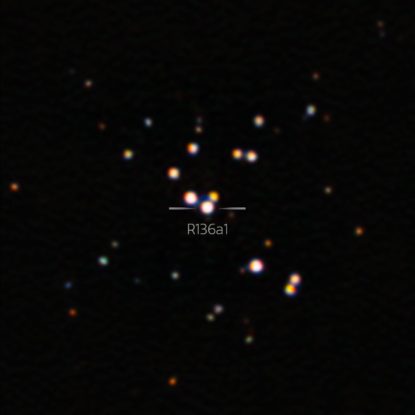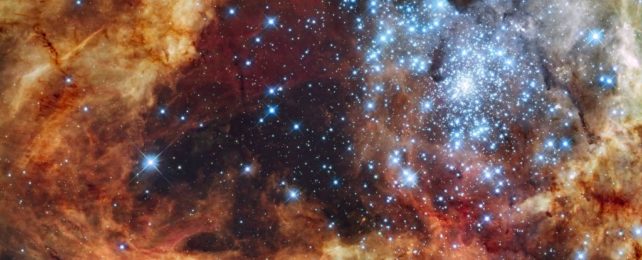How big can a star grow? Not as huge as we imagined, it turns out.
The sharpest images ever taken of the biggest known star indicate the upper limit to a sun's mass is probably a lot smaller than previous estimates.
The star R136a1 was initially measured at around 250 to 320 times the mass of our own Sun. The new estimate places it between 150 and 230 times the mass of the Sun.
This new ballpark figure of just under 200 solar masses still makes the star a heavyweight record holder, but the downward revision of its mass could have deeper implications.
The work was part of a project to understand the cluster in which it resides, called R136. It sits in the Tarantula Nebula, a hotbed of star formation in a satellite galaxy of the Milky Way called the Large Magellanic Cloud.
This cluster happens to contain some of the most massive stars known; masses that also have now been revised downwards. Since these masses are critical anchor points for the upper mass function of massive stars, the work could mean that our previous stellar upper mass limits are wrong.
"Our results show us that the most massive star we currently know is not as massive as we had previously thought," says astronomer and astrophysicist Venu Kalari of the Gemini Observatory. "This suggests that the upper limit on stellar masses may also be smaller than previously thought."
Although we don't know what the upper limit for star mass is, calculations and modeling suggest that there does have to be one. It's accepted that at a point known as the Eddington limit the outward pressure from the core's radiation exceeds the inward gravitational pressure, forcing material in the star's outer layers to be ejected.
Previous research set a firm 150 solar masses as the Eddington limit. Then new data on the R136 stars was acquired, with a whole bunch weighing in at significantly higher masses.
In addition to defying the Eddington limit, these stars – young, very hot, and very large – defied stellar formation models. Later research found that such chonkers can form through stellar mergers, but we still don't have a good answer on the Eddington limit problem.

Settling on an upper mass limit based on accurate reference points would go a long way towards solving this gnawing puzzle. Stellar mass can be calculated by obtaining precise observations that reveal the star's brightness and temperature. So Kalari and his colleagues set about obtaining new, sharper images of the cluster in general, and R136a1 in particular.
This gave the team the tools to devise the new mass of 196 solar masses (plus or minus a few dozen solar masses) for R136a1, and 151 and 155 solar masses for two other large stars in the cluster, R136a2 and R136a3 – down from 195-211, and 180-181 respectively.
This has implications for the production of heavy elements in the Universe. You may know that massive stars end up as black holes; they eject their outer material and a black hole forms from the collapsed stellar core. However, there's an upper limit for this: over about 130 solar masses, the star can explode in what is known as a pair-instability supernova, in which the entire star, core and all, goes boom.
During these incredibly violent events, subatomic processes result in the production of heavy elements. If there are fewer stars out there in this mass range, then we need to rethink the potential contribution pair-instability supernovae make to the heavy elements we observe out there in space.
"The importance of whether or not pair-instability supernovae exist cannot be overemphasized, as just one pair-instability supernova from a 300-solar mass star would produce and release more metals into the interstellar medium than an entire stellar mass function below it, which would completely change our understanding of galactic chemical evolution modeling," the researchers write in their paper.
However, this result was achieved by pushing the limit of the Zorro instrument on the Gemini South telescope, and the researchers urge caution in their interpretation of the findings.
The next step would be to try to validate the conclusions, perhaps by taking and comparing observations from another instrument.
The research has been accepted for publication in The Astrophysical Journal, and is available on arXiv.
